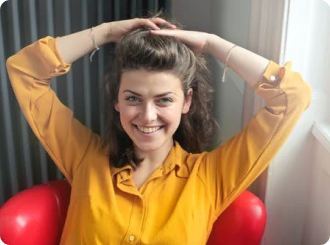Happiness Science




Exploring Happy Science
As humans, we all have attention biases and automatic thought patterns so when we see threats in certain situations: “what we look for, we see”. Gameface may retrain your brain to stop the automatic thought processes that focus on threat. It does this by retraining your brain to look for happy facial cues. The propensity to direct attention towards threat is a well-known correlation of people with anxiety. People with anxiety and depression have a higher tendency towards automatic negative thought patterns and biases and they perceive threat more readily than the general population.1
The Gameface app has been developed based on research as a game and mindfulness exercise that may be able to retrain attention bias.
WHAT IS ATTENTION BIAS?
We all have attention biases which are things you notice subconsciously and automatically in the world around you. For instance, a person who has a phobia of spiders will very likely notice (automatically) on entering a room, a spider’s web in the corner. On the other hand, someone who isn’t afraid of spiders will not pay any attention at all. Attention has a bias towards perceived threats. Think of it as a mental filter that looks for threat: ‘what we are looking for, we see more of’. It’s similar to when someone tells you about a certain type of car in conversation and then back on the road, you begin to see the same type of car everywhere.
Attention Bias is when you notice things unconsciously and automatically in the world around you. It has been shown that many people with anxiety are more likely to be vigilant to perceived threats in their environment. They are more likely to interpret ambiguous information in a negative way. For instance, it has been shown that neutral facial expressions are seen to be threatening or unfriendly for these sufferers.2
This is a limitation with their perception and unfortunately for the sufferer it is subconscious and automatic. A further limitation is that it is a vicious negative feedback loop. When a sufferer looks for a threat automatically, the more they will inevitably see threats through their filter. The more threats that are perceived, the more anxious they become and are more likely to look for these threats.3
THE SOLUTION?
The Gameface app has been developed based on research, as a game and mindfulness activity that may retrain these automatic reactions by modifying the attention bias away from threat and towards acceptance.4
HOW DOES THE APP WORK?
The idea is that out of the screen of faces, the aim is to find the most positive/happiest face amongst the emotive faces by looking consciously, repetitively and with speed. It does this by giving the user 9 different faces (to start with) - some sad, angry, indifferent, happy, worried etc. The app gets progressively harder and the real magic happens when the happy face/s and indifferent faces become imperceptibly similar, if not the same. It has been shown that this retrains the attention bias so that you begin to look consciously for positive social cues, effectively overriding the unconscious attention towards negative social cues and threat.5
HOW OFTEN DO I NEED TO TRAIN TO GET THE BENEFITS?
In one study the positive effects were seen in just 5 minutes. But from further studies the effective training timeframe is 3-5 minutes per day, at least 4 times per week. So approximately 40 minutes per month equates to effective training! It was also found the more frequently that individuals trained, the better they felt; less anxious and stressed.6
However, Gameface is not just effective for people with feelings of anxiousness. It may help healthy individuals too, as it increases feelings of social acceptance and boosts self-esteem. In an exam study (Dandeneau et al), university students who were studying for their final exams (which is considered to be a very stressful time), were broken up into two groups. One group played a control game of finding a certain flower among other flowers. The other group played the game searching for a smiling face. They played it for 5 consecutive days, 5 minutes per day leading up to, and inclusive of, the morning of their final exam. The group that played the search for the smiling face amongst negative faces, reported a significant reduction in stress about their final exam and were less anxious during the exam compared to the control group.7
In addition to this (Dandeneau & et al 2007), there was a sales performance study which is actually a real world example of not just helping people with feelings of anxiety and depression but everyone, as we all have a human need to be accepted and a fear of rejection. In the highly stressful workplace environment of telemarketers, a group of individuals who played the training game, experienced an increase in self-esteem and a decrease in perceived stress. In addition, this study tested the stress hormone cortisol and the group that played the game had a “reduction of 17% in their cortisol levels”. This is a physical indicator/marker of stress reduction. This group’s sales performance was also tested and they had an increase of “68.9% in their sales performance from training with the game.” In a series of experiments, positive effects of this type of training have been observed on self-esteem and stress-responses in healthy adults.8
WHAT OTHER STUDIES DEMONSTRATE?
Studies in this field have proven successful for both child and adult populations. In a 2015 study, Waters et al, concluded that “attention bias modification training (ABMT) is a promising treatment for anxiety disorders” and “that attention training towards positive stimuli, (happy faces) using visual search ABMT, has beneficial effects on anxiety and attention biases in children.”9
In further studies, consistent with earlier research in youth (de Voogd et al., 2014), found “positive visual search attentional training led to an increased bias for positive information…” This effect was most prominent in participants who completed many training sessions. This training induced an attention bias - “Attention to Positive (ATP) which produced significant clinical improvement” by directing children’s attention to positive stimuli (de Voogd) et al., 2014).10
Dandeneau, Baldwin and colleagues (2004) concluded from a field study that facial expressions are key social signals and they adopted a model whereby participants who automatically attend to negative bias, can train their brains to reduce anxiety. The present findings suggest that it is possible to measure people's attentional bias in relation to rejection.11
Other studies have also had positive results in ABMT; a 2010 meta-analysis of 12 studies concluded that "when we look at the studies collectively, we see that attentional bias modification really seems to work for anxiety disorders," says study co-author Yair Bar-Haim, PhD, a Clinical Psychologist and Neuroscientist at Tel Aviv University.12
Gameface is a real world application that benefits not only people with feelings of anxiety but can also be used as an enhancement tool/performance enhancer to help people with sales, self-esteem, general confidence and public speaking. Some studies indicate that traditional approaches like medication or counselling may not work in isolation, so novel approaches like ABMT may be used as a method to lessen anxieties, perhaps in parallel. “ABMT shows promise as a novel benefit for anxiety”. 13
This App may help you
- - gain and maintain a more positive frame of mind
- - encourage the use of mindfulness activities in everyday life for positive well-being
- - build general confidence and self-esteem, particularly in public speaking and sales
Happy ‘Gamefacing’!!
*We make no claims about the effectiveness of these games for helping any particular individual deal with any particular issue or problem. For the treatment of psychological problems, please consult a qualified mental health professional. This is an additional training tool to current psychological methods and does not replace the advice and/or treatments from mental health professionals”
REFERENCES
1. Dandeneau, S. D., Baldwin, M. W., Baccus, J. R., Sakellaropoulo, M., & Pruessner, J. C. (2007). Cutting stress off at the pass: reducing vigilance and responsiveness to social threat by manipulating attention. Journal of Personality and Social Psychology, 93(4), 651
2. Dandeneau, S. D., Baldwin, M. W., The Inhibition of Socially Rejecting Information Among People with High versus Low Self Esteem: The role of Attentional Bias and the Effects of Bias Reduction Training. Journal of Social and Clinical Psychology, Vol. 23, No. 4, 2004, pp. 584-602
3. Dandeneau, S. D., Baldwin, M. W., Baccus, J. R., Sakellaropoulo, M., & Pruessner, J. C. (2007). Cutting stress off at the pass: reducing vigilance and responsiveness to social threat by manipulating attention. Journal of Personality and Social Psychology, 93(4), 651
4. Dandeneau, S.D., Baldwin M.W., The buffering effects of rejection-inhibiting attentional training on social and performance threat among adult students 2009 Contemporary Educational Psychology, 34(1), 42–50
5. Dandeneau, S. D., Baldwin, M. W., The Inhibition of Socially Rejecting Information Among People with High versus Low Self Esteem: The role of Attentional Bias and the Effects of Bias Reduction Training. Journal of Social and Clinical Psychology, Vol. 23, No. 4, 2004, pp. 584-602
6. Dandeneau, S. D., Baldwin, M. W., Baccus, J. R., Sakellaropoulo, M., & Pruessner, J. C. (2007). Cutting stress off at the pass: reducing vigilance and responsiveness to social threat by manipulating attention. Journal of Personality and Social Psychology, 93(4), 651
7. Dandeneau, S. D., Baldwin, M. W., The Inhibition of Socially Rejecting Information Among People with High versus Low Self Esteem: The role of Attentional Bias and the Effects of Bias Reduction Training. Journal of Social & Clinical Psychology, Vol. 23, No. 4, 2004, pp 584-602
8. Dandeneau, S. D., Baldwin, M. W., Baccus, J. R., Sakellaropoulo, M., & Pruessner, J. C. (2007). Cutting stress off at the pass: reducing vigilance and responsiveness to social threat by manipulating attention. Journal of Personality and Social Psychology, 93(4), 651
9. Waters, A.M., Zimmer-Gembeck, M.J., Craske, M.G., Pine, D.S., Bradley, B.P., Mogg, K., Look for Good and Never Give Up: A Novel Attention Training Treatment for Childhood Anxiety Disorders, Behaviour Research and Therapy (2015), doi: 10.1016/j.brat.2015.08.005.
10. De Voogd E.L., R.W. Wiers, P.J.M. Prins, E. Salemink Visual search attentional bias modification reduced social phobia in adolescents. Journal of Behavior Therapy and Experimental Psychiatry Volume 45, Issue 2, June 2014, Pages 252-259
11. Dandeneau, S. D., Baldwin, M. W., The Inhibition of Socially Rejecting Information Among People with High versus Low Self Esteem: The role of Attentional Bias and the Effects of Bias Reduction Training. Journal of Social and Clinical Psychology, Vol. 23, No. 4, 2004, pp. 584-602
12. Bar-Haim, Yair., PhD, Attention Bias Modification Treatment: A meta-analysis towards the establishment of novel treatment for anxiety 2010 Biology Psychiatry. 2010 Dec 1;68(11):982-90. doi: 10.1016/j.biopsych.2010.07.021.
13. Hakamata, Y.,Lissek, S., Bar-Haim, Y., Britton, J.C., Fox, N.A., Leibenluft, M.E., Ernst, M., Pine, D. Attention bias modification treatment: a meta-analysis toward the establishment of novel treatment for anxiety Biology Psychiatry. 2010 Dec 1;68(11):982-90. doi: 10.1016/j.biopsych.2010.07.021.